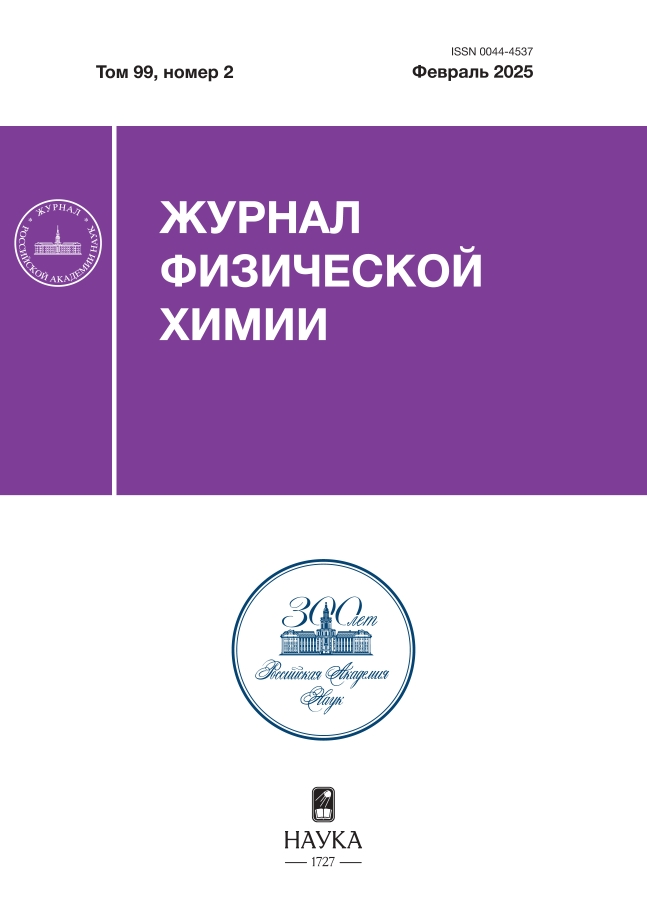Comparison of the catalytic properties of Pt and Co cathodes for the nitrite reduction reaction to ammonia
- Авторлар: Kuznetsova I.I.1, Lebedeva O.K.1, Kultin D.Y.1, Kustov L.M.1,2
-
Мекемелер:
- M. V. Lomonosov Moscow State University
- N. D. Zelinsky Institute of Organic Chemistry, Russian Academy of Sciences
- Шығарылым: Том 99, № 2 (2025)
- Беттер: 331-338
- Бөлім: ELECTROCHEMISTRY. GENERATION AND STORAGE OF ENERGY FROM RENEWABLE SOURCES
- ##submission.dateSubmitted##: 19.06.2025
- ##submission.datePublished##: 20.05.2025
- URL: https://stomuniver.ru/0044-4537/article/view/685284
- DOI: https://doi.org/10.31857/S0044453725020205
- EDN: https://elibrary.ru/DCWCKT
- ID: 685284
Дәйексөз келтіру
Аннотация
The electrochemical reaction reduction of nitrites (NO2−RR) in a neutral aqueous electrolyte is studied, which has important applications both for future ammonia synthesis processes and for effective wastewater and agricultural wastewater treatment. The catalytic activity is compared (the results of the Faradaic efficiency and the yield rate of ammonia are obtained) for noble (platinum) and non-noble (cobalt) metals. Metallic polycrystalline platinum and cobalt serve as electrocatalyst. The surface of the catalysts is analyzed using SEM and light microscopy. The method of linear voltammetry is used to preliminarily identify the potential of ammonia synthesis and estimate the synthesis current density. The values of Faradaic efficiency (FE) and the yield rate of ammonia release are obtained for the five selected values of current densities (J). It is found that the cobalt cathode is more efficient (FE ≈ 99%, yield rate (NH3) = 2.4 mmol h–1 cm–2), which exceeds the values for the platinum cathode ((FE = 88.1%, yield rate (NH3) = 0.4 mmol h–1 cm–2). The electrochemically active surface (ECSA) of the electrocatalysts is determined. The explanation of such activity of catalysts is given according to the results of the work that demonstrate that a non-noble metal cathode can be more effective for NO2−RR.
Негізгі сөздер
Толық мәтін
Авторлар туралы
I. Kuznetsova
M. V. Lomonosov Moscow State University
Email: lmkustov@mail.ru
Department of Chemistry
Ресей, Moscow, 119991O. Lebedeva
M. V. Lomonosov Moscow State University
Email: lmkustov@mail.ru
Department of Chemistry
Ресей, Moscow, 119991D. Kultin
M. V. Lomonosov Moscow State University
Email: lmkustov@mail.ru
Department of Chemistry
Ресей, Moscow, 119991L. Kustov
M. V. Lomonosov Moscow State University; N. D. Zelinsky Institute of Organic Chemistry, Russian Academy of Sciences
Хат алмасуға жауапты Автор.
Email: lmkustov@mail.ru
M. V. Lomonosov Moscow State University, Department of Chemistry
Ресей, Moscow, 119991; Moscow, 119991Әдебиет тізімі
- Makepeace J.W., He T., Weidenthaler C. et al. // Int. J. Hydrogen Energy. 2019. V. 44. P. 7746. https://doi.org/10.1016/j.ijhydene.2019.01.144
- John J., MacFarlane D.R., Simonov A.N. // Nat. Catal. 2023. V. 6. P. 1125. https://doi.org/10.1038/s41929-023-01060-w
- Lebedeva O., Kultin D., Каlenchuk A., Кustov L. // Curr. Opin. Electrochem. 2023. V. 38. P. 101207. https://doi.org/10.1016/j.coelec.2022.101207
- Imamura K., Kubota J. // Sustainable Energy Fuels. 2019. V. 3. Р. 1406. https://doi.org/10.1039/C9SE00049F.
- Shao J., Jing H., Wei P. et al. // Nat. Energy. 2023. V. 8. Р. 1273. https://doi.org/10.1038/s41560-023-01386-6
- Murphy E., Liu Y., Matanovic I. et al. // Nat. Commun. 2023. V. 14. Р. 4554. https://doi.org/10.1038/s41467-023-40174-4
- Bai L., Franco F., Timoshenko J. et al. // J. Am. Chem. Soc. 2024. V. 146. Р. 9665. https://doi.org/10.1021/jacs.3c13288
- Jiang Z., Wang Y., Lin Z. et al. // Energy Environ. Sci. 2023. V. 16. Р. 2239. https://doi.org/10.1039/D2EE03502B
- Kuznetsova I., Lebedeva O., Kultin D. et al. // Int. J. Mol. Sci. 2024. V. 25. Р. 7089. https://doi.org/10.3390/ijms25137089
- Jiang Z., Wang Y., Lin Z. et al. // Energy Environ. Sci. 2023. V. 16. Р. 2239. https://doi.org/10.1039/D2EE03502B
- Petrii O.A., Safonova T.Ya. // J. Electroanal. Chem. 1992. V. 331. Р. 897. https://doi.org/10.1016/0022-0728(92)85013-S
- Xiang J., Qiang C., Shang S. et al. // Adv. Funct. Materials. 2024. Р. 2401941. https://doi.org/10.1002/adfm.202401941
- Zhao H., Xiang J., Sun Z. et al. // ACS Sustainable Chem. Eng. 2024. V. 12. Р. 2783. https://doi.org/10.1021/acssuschemeng.3c07388
- Wang F., Xiang J., Zhang G. et al. // Nano Res. 2024. V. 17. Р. 3660. https://doi.org/10.1007/s12274-023-6261-2
- Wang F., Zhao H., Zhang G. et al. // Adv. Funct. Materials. 2024. V. 34. Р. 2308072. https://doi.org/10.1002/adfm.202308072
- Wang F., Shang S., Sun Z. et al. // Chem. Eng. J. 2024. V. 489. Р. 151410. https://doi.org/10.1016/j.cej.2024.151410
- Xiang J., Zhao H., Chen K. et al. // J. Colloid Interface Sci. 2024. V. 653. Р. 390. https://doi.org/10.1016/j.jcis.2023.09.095
- Xiang J., Zhao H., Chen K. et al. // Ibid. 2024. V. 659. Р. 432. https://doi.org/10.1016/j.jcis.2024.01.013
- Wan Y., Du W., Chen K. et al. // Ibid. 2023. V. 652. Р. 2180. https://doi.org/10.1016/j.jcis.2023.09.071
- Wu T., Zhang F., Wang J. et al. // Dalton Trans. 2024. V. 53. Р. 877. https://doi.org/10.1039/D3DT03808D
- Li Y., Ouyang L., Chen J. et al. // J. Colloid Interface Sci. 2024. V. 663. Р. 405. https://doi.org/10.1016/j.jcis.2024.02.153
- Qu Y., Guo Y., Chu K. // Inorg. Chem. 2024. V. 63. Р. 78. https://doi.org/10.1021/acs.inorgchem.3c04194
- Zhang Y., Wan Y., Liu X. et al. // iScience. 2023. V. 26. Р. 107944. https://doi.org/10.1016/j.isci.2023.107944
- Dima G.E., De Vooys A.C.A., Koper M.T.M. // J. Electroanal. Chem. 2003. V. 554–555. Р. 15. https://doi.org/10.1016/S0022-0728(02)01443-2
- De Groot M.T., Koper M.T.M. // J. Electroanal. Chem. 2004. V. 562. Р. 81. https://doi.org/10.1016/j.jelechem.2003.08.011
- Lebedeva O., Zakharov V., Kuznetsova I. et al. // Chem. – Eur. J. 2024. V. 30. Р. e202402075. https://doi.org/10.1002/chem.202402075
- Adalder A., Mitra K., Barman N. et al. // ChemRxiv. 2024. https://doi.org/10.26434/chemrxiv-2024-v8chs
Қосымша файлдар













